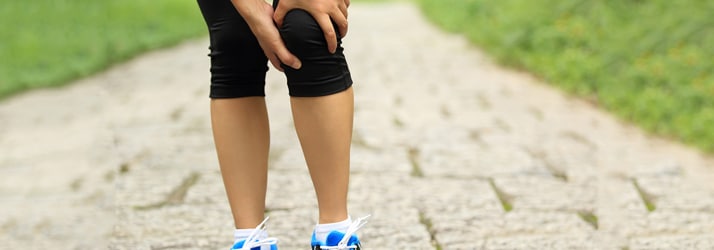Knee, Ankle, & Foot Pain
Knee, Ankle, & Foot Pain

The lower extremity has a significant impact on your ability to move within your world. A series of moving links (hip, knee and ankle joints) work cooperatively in dynamic and static states. This capacity affords us the opportunity to proficiently move, perform and pursue our passion in life. An understanding of these articulations, muscles, joints and their biomechanics should help in sustaining our quest to stay healthy and active!
Specialized sensory receptors in the body (muscles, tendons ligaments and joints) have a proprioceptive function, meaning they relay positional or spatial awareness to your brain in order to maintain upright balance. This is accomplished through a constant stream of information flowing from our body into our spine and up into our brain. Neuropathways, or somatic sensory circuits, create a sense of self as we move our body parts through space and time.
Joints
The knee joint is the largest, most complex joint in the body designed for stability. It is a modified "hinge" joint that flexes and extends with very little rotation or twisting. Stability is dependent on a complex network of thick, strong ligaments inside and outside the joint. Mobility must exist above and below the knee joint in the hip and ankle joint. If the hips are tight and stiff, the knee joint is vulnerable to excessive motion that can create wear and tear. The patella (also known as the knee cap) is the largest "sesamoid" bone in the body and glides between the two round surfaces on the femur bone with knee flexion/extension. On top of the tibia bone sits two shock-absorbing pads, called the menisci, which help to deepen the knee joint surface area in a figure-eight-like pattern. This meniscus pattern shares connections with the cruciate ligaments and assists in guiding the small amount of rotation in the knee.
The foot and ankle are key focal points of support for total body weight forces. Every day we endure concentrated forces of stress through the ankle, which acts as a shock absorber and distributes those forces into the foot. The ankle joint consists of two primary hinge-type joints, the talocrural and subtalar joints. While upright and in gravity, these joints are constantly adapting to the accommodations necessary to stand, walk, run or jump. The fibula and tibia bones from above, and the talus bone from below, form the talocrural joint, which is a hinge joint. The talus and calcaneus make up the subtalar joint. These complex movements in the human frame require intricate and subtle relationships governed by neuromuscular reflexes, provided by our nerves, spinal cord, and brain.
Ligaments
- Medial Collateral Ligament (MCL): A superficial, long and flat ligament between the medial epicondyle of the femur and the tibia (4 - 7 cm); stabilizes the inside of the knee joint; resists excessive external rotation and abduction.
- Medial Capsular Ligament (MCL): Deep, thick, and attaches to the medial meniscus; shares fibers of the joint capsule; resists inward or valgus stress and medial rotation; stabilizes anterior-posterior movement assisting the anterior cruciate ligament.
- Lateral Collateral Ligament (LCL): A strong cord-like ligament attaching from the lateral epicondyle of the femur to the top or superior head of the fibula; does not attach to the meniscus; resists outward or external rotation of the femur on the tibia; not injured as much as the MCL due to its lack of meniscal attachment.
- Anterior Cruciate Ligament (ACL): A strong intra-articular ligament that runs front-to-back (anterior to posterior); fibers are taut with straight leg; prevents the femur from moving backwards or posteriorly on the tibia.
- Posterior Cruciate Ligament (PCL): An intra-articular ligament that attaches back-to-front (posterior to anterior); prevents forward movement of the tibia relative to the femur and internal rotation of the tibia
- Patellar Ligament: Common tendon of quadriceps muscle inserts on tibial tuberosity
Muscles
- Quadriceps: The largest muscle mass in the body: Rectus Femoris, Vastus Lateralis, Vastus Medialis, Vastus Intermedius. Its action is extension of the knee, flexion of hip (Rectus Femoris only), and tracking of Patella (Vastus Lateralis and Medialis)
- Sartorius: A flexor and external rotator of hip joint and flexor of knee joint, and the longest muscle in the body
- Hamstrings: Semimembranosus, Semitendinosus & Biceps Femoris. Its action is flexion of the knee, extension of hip, deceleration of leg, stability functions with knee extension
- Popliteus: Small muscle that flexes the tibia and rotates it medially
- Iliotibial (IT) Band: Tendinous extension of the tensor fasciae latae and gluteus maximus Gastrocnemius. The two heads (lateral and medial) insert above knee; common tendon (Achilles) insets on the calcaneus; influences knee flexion and ankle plantar flexion.
Range of Motion
Standing with both feet on the floor (Closed Kinetic Chain) with a straight or "locked knee" creates zero degrees of flexion due to ligaments, meniscus and joint capsule being tight and at maximum tension. As the knee moves into flexion, the knee "unlocks" and the femoral head and lateral condyle externally rotate slightly and the medial condyle glides or translates in the first 15-20 degrees. Rotational movement is greatest between 45-90 of knee flexion. Knee flexion (120-150 degrees) and extension or hyperextension (5-10 degrees).
Ligaments
- Medial Collateral or "Deltoid" Ligament: A thick, strong triangular ligament on the medial side of ankle; from the medial malleolus above, it fans out and inserts on three ankle bones (navicular, calcaneus, talus)
- Lateral collateral ligament: Three distinct ligaments (calcaneofibular, anterior/ posterior talofibular) and considerably weaker than its medial counterpart; prone to ankle "inversion" sprains
Muscles
- Anterior Leg: Tibialis Anterior, Extensor Digitorium Longus, Extensor Hallucis Longus (Anterior Shin Splints)
- Posterior Leg: Tibialis Posterior, Flexor Digitorum Longus, Flexor Hallucis Longus, (Posterior Shin Splints), Plantaris, Triceps Surae, Gastrocnemius (superficial and soleus/deep)
- Lateral Leg: Peroneal Tertius, Peroneal Longus, Peroneal Brevis
- Foot (Dorsal): Extensor Digitorum Brevis, Extensor Hallucis Brevis, Interossei
- Foot (Plantar): Abductor Hallucis, Abductor Digiti Minimi, Flexor Digitorum Brevis, Quadratus Plantae, Lumbricles, Flexor Hallucis Brevis, Adductor Hallucis, Flexor Digiti Minimi Brevis, Interossei
Range of Motion
- Talocrural Joint: Dorsiflexion (20-30 degrees); Plantarflexion (40-50 degrees)
- Subtalar Joint: Supination or Inversion (20 degrees); Pronation or Eversion (10 degrees)
Ankle & Foot Arches
The 3 arches in the foot create support with a suspension-like capacity. The talus bone is considered the "keystone" of support in the arch of the foot. It gives us information for our balance and posture. It allows us to move with precision and power when activities demand it. Strengthening the arches must happen over time and with understanding of proper biomechanics. The 3 arches of the foot are: Medial Longitudinal Arch, Lateral Longitudinal Arch, Transverse Arch.
Squat Test
Perform a squat 5-6 times with good, upright posture (looking straight ahead, feet hip-width and parallel, using a postural grid in the background for reference. You can also take a video or picture (front and lateral views) to check for the structural dysfunctions that may occur below.
- Knees move inward of ankles. Right or Left
- Inside arch of foot collapses (pronation/Inversion) Right or Left
- Foot rotates laterally: Right or Left
- Spine flexes forward/dowel angles forward. More than 30 degrees? Y / N
- Pelvis shifts or translates: Right or Left
- Heels lift off floor: Yes / No
- Toes grip floor for balance: Yes / No
Key considerations while performing the squat:
- Knees should align vertically above ankles
- Inside or medial arch should be maintained. If arch flattens or pronates, this can stretch the soft tissues (plantar fascia/aponeurosis), leading to plantar fascitis or achilles tendonitis
- Feet should stay pointing straight ahead and not flare out
- Poor flexibility through the ankle and hip joints creates imbalance posteriorly and the upper body will counter-balance by leaning forward respectively.
- Asymmetry through old injuries or poor postural habits over the years causes the pelvis to shift laterally or side-to-side, compensating to maintain stability
- Tight calf muscles limit the ankle joint in dorsiflex (see #4). When stability is compromised due to body weight moving forward, intrinsic foot muscles have to work hard to resist falling forward and losing balance.
Office Hours
Monday
7:00am - 7:00pm
Tuesday
7:00am - 7:00pm
Wednesday
7:00am - 7:00pm
Thursday
7:00am - 7:00pm
Friday
7:00am - 7:00pm
Saturday
8:00am - 1:00pm
Monday
8:00am - 8:15pm
Tuesday
8:00am - 8:15pm
Wednesday
8:00am - 8:15pm
Thursday
8:00am - 8:15pm
Friday
8:00am - 8:15pm
Saturday
9:00am - 2:00pm
Monday
10:00am - 6:00pm
Tuesday
10:00am - 6:00pm
Wednesday
8:00am - 4:00pm
Thursday
10:00am - 6:00pm
Friday
8:00am - 2:00pm
Saturday
Closed
Arise Chiropractic and Wellness
100 Kalamalka Lake Road #7
Vernon, BC V1T 9G1
Chiro / Massage:
(250) 275-7616
Physiotherapy:
(250) 309-1346
Fax:
(250) 275-7618

